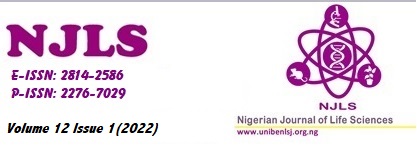CHARACTERISATION OF SULPHATE-REDUCING BACTERIAL BIOFILMS FROM CRUDE OIL AND PRODUCED WATER AT LAMINAR FLOW
DOI:
https://doi.org/10.52417/njls.v6i1.292Keywords:
Biofilm, Sulfate-reducing bacteria, Laminar flow, Surface attachment, Crude oil, Produced water.Abstract
Characterisation of sulfate-reducing bacterial biofilms from crude oil and produced
water at laminar flow was carried out with the aid of a flow-cell set-up, using In situ
image microscopy. Biofilms of sulfate-reducing bacteria (SRB) indigenous to crude
oil (sample A) and produced water (sample B), were grown in square section glass
capillary flow cells at 55 ?C. Image analysis revealed predominantly clusters of cells
made up of both coccoid and rod-shaped bacteria, ranging in length from 1-3 ?m,
and some short chain and single cells with a variety of cell sizes demonstrating the
varied number of consortia in the mixed biofilm. Biofilm surface area cover showed
increase in surface area covered with time. Statistical significance of the means of
Differential Interference Contrast (DIC) microscopy images of biofilm from both
samples was determined and a p-value of less than 0.05 was considered significant.
Results from statistical analysis showed that there was significant difference
between biofilms of both samples, while there was no significant difference between
means within each sample. A significant difference in biofilm cover and possible
gene expression between both samples at 55 ?C during laminar flow was therefore
implied

Published
Issue
Section
License
Copyright (c) 2016 https://www.unibenlsj.org.ng/index.php/njls

This work is licensed under a Creative Commons Attribution 4.0 International License.





